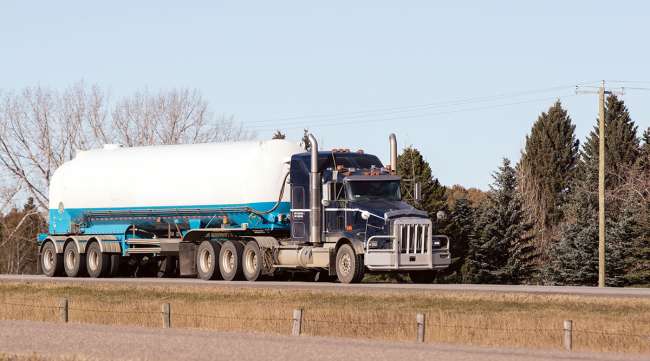Staff Reporter
Canada Mandates New Dangerous Goods Transport Database

[Stay on top of transportation news: Get TTNews in your inbox.]
Canada is implementing a new database requiring registration by next year for people and companies importing, offering to transport, handling or transporting dangerous goods at a domestic site they own or operate to gather an accurate national picture of the situation.
“In order to protect Canadians, it is necessary to know where dangerous goods are located and how they are being transported," Transport Minister Pablo Rodriguez said. "With the new Client Identification Database, Transport Canada will be able to do its work more efficiently to protect Canadians from coast to coast to coast."
Emphasizing a government commitment to public safety and security, Rodriguez announced Nov. 3 the launch of both the new registration requirements and the online database to reduce risks from the transportation of dangerous goods within Canada.
These new regulations — which took effect Oct. 25 after being published in the government’s newspaper, Canada Gazette, Part II — will give Transport Canada more current and accurate information about those moving dangerous goods.

Rodriguez
Until now, the Canadian government noted it lacked an actual number of sites that handle dangerous goods. It has collected information identifying 19,600 sites but estimates there could be from 42,000 to 82,000 places operating in Canada that handle dangerous goods.
“As a result of having no regulated way to collect data on sites in a standardized manner, or to account for all sites in Canada, any information gathered to date has been obtained through a patchwork of data sources, public complaints and inspection reports, leaving room for inaccuracies, duplications and out-of-date information,” the government said. “This patchwork method for gathering information about sites is insufficient to provide inspectors with the information needed to determine whether a site should be prioritized for inspection.”
Between 2009 and 2021, Transport Canada was notified about 2,500 reportable on-site dangerous goods incidents, but only 84 happened in places included within the agency’s oversight system. “In other words, 96.6% of these reported incidents occurred on sites that were unknown to TC and, therefore, uninspected,” the government stated.
People and organizations subject to the rules must input information into the database about the dangerous goods being imported, offered for transport, handle or moved as well as locations of the materials. The information must be updated annually.
The new mandates will result in 42,000 small businesses involved in dangerous goods transportation having to pay a cost of $5.82 million over 10 years starting this year, according to a government analysis.
Check out Transport Topics' updated Top 50 list of the largest freight transportation companies in the world and explore how these companies are re-evaluating their supply chains. Tune in above or by going to RoadSigns.ttnews.com.
The Canadian government’s price tag will be $2.98 million associated with reporting requirements plus implementing and maintaining the database.
Dangerous goods are grouped into nine classes of materials based on a substance’s characteristics and properties, including flammable liquids, gases, explosives, radioactive materials, corrosive substances, toxic substances and substances that on contact with water emit flammable gases.
According to the revised “Transportation of Dangerous Goods Regulations,” information collected through the new database will help the Canadian government ensure requirements for moving dangerous goods “are administered and enforced consistently and appropriately according to risk across the transportation sector” to lower the likelihood and severity of incidents.
With some exceptions, the regulation mandates that individuals and organizations must register their organizations in the database no later than Oct. 25, 2024.
The regulations exempt those transporting dangerous goods originating from outside Canada and passing through the country for a non-Canadian destination without any handling being done in Canada. It also excludes a person conducting cross-border movements who lacks a Canadian headquarters in Canada or site for importing, offering for transport, handling or transporting activities.

An oil refinery in Canada. For the oil and gas industry, sites include terminals, refineries and distribution centers where dangerous good activities are conducted with the intent of being transported. (Aaron McKenzie Fraser/Bloomberg News)
“For the freight-forwarding industry, if the person offering for transport is never in direct possession of the dangerous goods, this person will not be required to register,” the regulation says.
However, a consignor of dangerous goods must register locations where dangerous good activities are conducted. For example, a chemical company will need to register any site where dangerous goods are prepared for and offered for transport.
For the oil and gas industry, sites include terminals, refineries and distribution centers where dangerous good activities are conducted with the intent of being transported.
Want more news? Listen to today's daily briefing above or go here for more info
Transport Canada’s inspectors may issue fines of up to $1,000 for noncompliance with the new regulations. In extreme or repetitive cases, criminal prosecution is possible.
After the Client Identification Database has been in place for one year, penalties may be imposed for noncompliance, up to and including criminal prosecution for extreme or repeated infractions.
Once more information is entered into the registration database, government officials can determine public safety risk levels, prioritize site visits and define inspection cycles.





